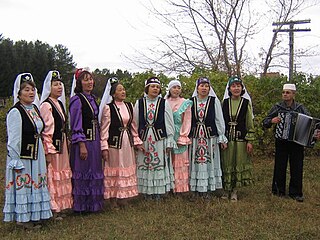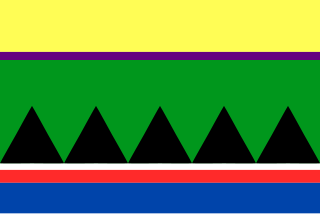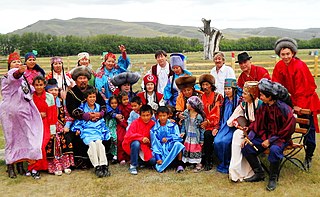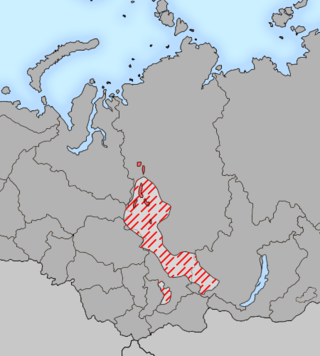
The Turkic peoples are a collection of diverse ethnic groups of West, Central, East, and North Asia as well as parts of Europe, who speak Turkic languages.

The Bashkirs or Bashkurts are a Kipchak-Bulgar Turkic ethnic group indigenous to Russia. They are concentrated in Bashkortostan, a republic of the Russian Federation and in the broader historical region of Badzhgard, which spans both sides of the Ural Mountains, where Eastern Europe meets North Asia. Smaller communities of Bashkirs also live in the Republic of Tatarstan, the oblasts of Perm Krai, Chelyabinsk, Orenburg, Tyumen, Sverdlovsk and Kurgan and other regions in Russia; sizable minorities exist in Kazakhstan and Uzbekistan.
The Udmurts are a Permian (Finno-Ugric) ethnic group in Eastern Europe, who speak the Udmurt language. During the course of the Russian Empire, Udmurts have been referred to mainly as Chud Otyatskaya, Otyaks, Wotyaks or Votyaks, all being exonyms. Today such exonyms are considered offensive by Udmurts themselves and are mainly used against those who have forgotten the Udmurt language. The Udmurts are closely related to Komis to their north, both linguistically and culturally.
The Gagauz are a Turkic ethnic group native to southern Moldova and southwestern Ukraine (Budjak). Gagauz are mostly Eastern Orthodox Christians. The term Gagauz is also often used as a collective naming of Turkic people living in the Balkans, speaking the Gagauz language, a language separated from Balkan Gagauz Turkish.

The Chuvash people, plural: чӑвашсем, çăvaşsem; Russian: чува́ши ) are a Turkic ethnic group, a branch of the Ogurs, native to an area stretching from the Idel-Ural (Volga-Ural) region to Siberia.

The Besermyan, Biserman, Besermans or Besermens are a numerically small Permian people in Russia.

Veps, or Vepsians, are a Finnic people who speak the Veps language, which belongs to the Finnic branch of the Uralic languages.

Siberian Tatars or Sybyrs/Sibirs are the indigenous Turkic-speaking population of the forests and steppes of Western Siberia, originating in areas stretching from somewhat east of the Ural Mountains to the Yenisey River in Russia. The Siberian Tatars call themselves Yerle Qalıq, to distinguish themselves from more recent Volga Tatar immigrants to the region.

The Khakas are a Turkic indigenous people of Siberia, who live in the republic of Khakassia, Russia. They speak the Khakas language.

The Selkup are a Samoyedic speaking Uralic ethnic group native to Siberia. They live in the northern parts of Tomsk Oblast, Krasnoyarsk Krai and Tyumen Oblast. Selkups from 1850s until the 1930s exclusively in the scientific literature were called Ostyak-Samoyeds. This ethnonym has never been widely used.

Kamasins were a collection of tribes of Samoyedic peoples in the Sayan Mountains who lived along the Kan River and Mana River in the 17th century in the southern part of today's Krasnoyarsk Krai.

Mator or Motor was a Uralic language belonging to the group of Samoyedic languages, extinct since the 1840s. It was spoken in the northern region of the Sayan Mountains in Siberia, close to the Mongolian north border. The speakers of Mator, Motorians or Motors, lived in a wide area from the eastern parts of the Minusinsk District (okrug) along the Yenisei River to the region of Lake Baikal. Three dialects of Mator were recorded: Mator proper as well as Taygi and Karagas. Mator was influenced by Mongolic, Tungusic and Turkic languages before it went extinct, and may have even been possibly influenced by the Iranic languages.

Khakas, also known as Xakas, is a Turkic language spoken by the Khakas, who mainly live in the southwestern Siberian Republic of Khakassia, in Russia. The Khakas number 73,000, of whom 42,000 speak the Khakas language. Most Khakas speakers are bilingual in Russian.

The Volga Tatars or simply Tatars are a Kipchak-Bulgar Turkic ethnic group native to the Volga-Ural region of Eastern European Russia. They are subdivided into various subgroups. Volga Tatars are the second-largest ethnic group in Russia after ethnic Russians. Most of them live in the republics of Tatarstan and Bashkortostan. Their native language is Tatar, a language of the Turkic language family. The predominant religion is Sunni Islam, followed by Orthodox Christianity.

The Yenisei Kyrgyz, were an ancient Turkic-speaking people who dwelled along the upper Yenisei River in the southern portion of the Minusinsk Depression from the 3rd century BCE to the 13th century CE. The heart of their homeland was the forested Tannu-Ola mountain range, in modern-day Tuva, just north of Mongolia. The Sayan mountains were also included in their territory at different times. The Yenisei Kyrgyz Khaganate existed from 538 to 1219 CE; in 840, it took over the leadership of the Turkic Khaganate from the Uyghurs, expanding the state from the Yenisei territories into Central Asia and the Tarim Basin.
Leonid Pavlovich Potapov was a Soviet and Russian ethnographer specializing in the study of peoples of southern Siberia.
The Abugach or, to the Russians, Abugachaevtsy, were a people from the region around the Ural Mountains and believed to have been of Samoyed ancestry. Witnesses from the 19th century, however, identify their spoken language as Turkic. Eventually, the Abugach became one of the ethnic groups that made up the Koibal sub-division of the Khakass.

The Yeniseian people refers either to the modern or ancient Siberian populations speaking Yeniseian languages. Despite evidence pointing to the historical presence of Yeniseian populations throughout Central Siberia and Northern Mongolia, only the Ket and Yugh people survive today. The modern Yeniseians live along the eastern middle stretch of the Yenisei River in Northern Siberia. According to the 2021 census, there were 1,088 Kets and 7 Yugs in Russia.
The Koibal dialect is a dialect of the Kamassian language or arguably another independent Sayan Samoyed language. About 600 words of the Koibal dialect are known, but there are no grammatical descriptions of Koibal. The vocabulary of Koibal is very similar to Kamassian proper. The Koibal dialect died around the 19th century. The Koibals assimilated into Turkic tribes. There was a Koibal-Russian glossary published in 1806. It is possible that it has a SOV word order, as so does Kamassian.
Khakass alphabets are the alphabets used to write the Khakas language.













